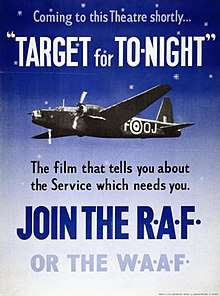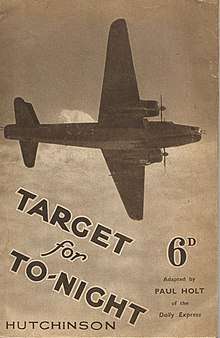Target for Tonight
Target for Tonight (or Target for To-Night) is a 1941 British documentary film billed as filmed and acted by the Royal Air Force, all while during wartime operations. It was directed by Harry Watt for the Crown Film Unit. The film is about the crew of a Wellington bomber partaking in a bombing mission over Germany. The film won an honorary Academy Award in 1942 as "Best Documentary" by the National Board of Review.[2]
| Target for Tonight | |
|---|---|
 Original theatrical poster | |
| Directed by | Harry Watt |
| Produced by | Harry Watt |
| Starring | Royal Air Force personnel |
| Music by | Central Band of the Royal Air Force |
| Edited by | S. McAllister |
Production company | |
| Distributed by | British Ministry of Information Associated British Film Distributors |
Release date |
|
Running time | 48 minutes |
| Country | United Kingdom |
| Language | English |
| Budget | £7,000[1] |
| Box office | £100,000[1] |
Plot
After text cards explaining RAF Bomber Command chain of command, the film begins with a reconnaissance aircraft flying over an RAF base and dropping a box of undeveloped film. After developing and analysis, it reveals that a major oil storage facility has been built by Nazi Germany in the Freiburg region. A squadron of Wellingtons is allocated to attack it that night. The planning of a mission to reach and hit the target is depicted, detailing how munitions for the task are selected. The weather forecast is expected to be good, and the aircrews are briefed. Among the pilots is P. C. Pickard, a real life RAF officer and holder of the DSO, who will pilot the Wellington "F for Freddie".
Once the briefing is completed the crew suit up, are driven to their bomber and take off in the dusk. Over Germany the target is bombed, but the aircraft is hit by flak. The radio operator suffers a wound to his leg, his set is put out of action and a hit to the port engine means that the aircraft can barely hold altitude. Pickard's is the last aircraft to return, by which time fog covers the airfield. Tension builds as he finds the base and brings the damaged plane down safely. No aircraft are lost from the mission and the target was set ablaze, so it is considered a complete success.[3]
Production
The film was shot by the Royal Air Force Film Unit[4] at RAF Mildenhall and at actual RAF Bomber Command headquarters in High Wycombe, with the head of Bomber Command Sir Richard Peirse and Senior Air Staff Officer Sir Robert Saundby appearing in the film.[5] In order to avoid giving information to the enemy, RAF Mildenhall took the fictitious name of "Millerton Aerodrome", and several other aspects of day-to-day operations of the command were altered. Squadron Leader Dickson, who skippered "F for Freddie", was played by Percy Charles Pickard, who went on to lead Operation Biting and Operation Jericho, a raid to release prisoners from the Amiens Prison. During this mission Pickard lost his life, as did his navigator, Flight Lieutenant J. A. "Bill" Broadley. The second pilot in the film was played by Gordon Woollatt. Also appearing (and uncredited) is Constance Babington Smith, who was a serving WAAF officer at the time and was responsible for photographic interpretation of aerial reconnaissance pictures.[6] Appearing in the control room scene is motor racing driver John Cobb, then a serving RAF officer.[7]
Film brochure

A 30-page brochure entitled The Book of the famous film Target for To-Night and sub-titled The Record in Text and Pictures of a Bombing Raid on Germany was released in 1941. It covered various scenes from the film along with photographic stills and was sold for 6d (six old pence). It was adapted from Harry Watt's screenplay by Paul Holt of the Daily Express.
Reception
According to Warner Bros the film earned that studio $229,000 domestically and $18,000 foreign.[8]
Popular culture
At the end of the war Harry Watt, the film's director, noted with regret that most of the flight officers and crew who appeared in the film did not survive the duration of the war.[9] For example, the front gunner in the film was played by Flight-sergeant Joseph Ronald Bird who lost his life on the 27/28 August 1942 flying as rear gunner of a Short Stirling aircraft whilst on a bombing mission to Kassel, Germany.[10][11][12]
The January 1987 episode of Allo! Allo!, "Pretty Maids All In A Row", contains a scene where the rescue of two British airmen by plane is hampered by the fact that all spare British aircraft are currently being used for a movie named F For Freddie.
Scenes from the film were included in the British World War II documentary The World at War, in the episode "Whirlwind".
Herman Wouk, in his novel The Winds of War, included a Wellington bomber christened "F for Freddie" in an episode of the story. The lead character, American naval captain Victor Henry, flies onboard "F for Freddie" as an observer during a bombing mission over Berlin. Wouk's fictional narrative evokes portions of the real "F for Freddie"'s mission log: one of their bombs hits their target squarely and flak damages the plane and injures one of their crew members in the leg (in the novel, the rear gunner rather than the radio operator). They have trouble holding altitude but make it back after a long, tense flight over hostile territory.
A possible identity of "F for Freddie" is Wellington Mk 1c OJ-F (P2517) which was serving with No. 149 Squadron from November 1940 to September 1941.[13][14]
References
- "Australia's film future lies in documentaries". The Argus. Melbourne, Victoria: National Library of Australia. 14 August 1944. p. 6. Retrieved 20 August 2012.
- "Target for Tonight (1941)". BFI. Retrieved 14 October 2018.
- "Target for Tonight (1941) Synopsis". BFI. Retrieved 14 October 2018.
- Connelly, Mark (2001). Reaching for the stars a new history of Bomber Command in World War II. London: I.B. Tauris. pp. 59–61. ISBN 1-86064-591-7.
- Johnston & Carter (2002), p. 141.
- Babington Smith, Constance (1957). Evidence in Camera: The story of Photographic Intelligence in World War II. London: Chatto & Windus. OCLC 7366816.
- "John Cobb". Flight. LXII (2280): 439. 3 October 1952. Retrieved 26 May 2015.
- Warner Bros financial information in The William Shaefer Ledger. See Appendix 1, Historical Journal of Film, Radio and Television, (1995) 15:sup1, 1-31 p 22 DOI: 10.1080/01439689508604551
- Ashcroft 2013.
- "Roll of Honour". No. 218 (Gold Coast) Squadron 1936-1945.
- NZ National Archive/Aukland Star newspaper, December 24 1942/Article 'Luck and Skill' (the memoirs of Pilot Officer A. T. Rowe).
- http://www.backtonormandy.org
- "Bomber Command No.149 Squadron". Royal Air Force. 2015. Retrieved 26 May 2015.
- "Vickers Wellingtons of 149 Squadron, 1940". The Air Tactical Assault Group. 2015. Retrieved 26 May 2015.
Bibliography
- Ashcroft, Michael A (2013). Heroes of the Skies. Headline Book Publishing.CS1 maint: ref=harv (link)
- Johnston, John & Carter, Nick (2002). Strong by Night: History and Memories of No. 149 (East India) Squadron Royal Air Force, 1918/19 – 1937/56. Tunbridge Wells, Kent, UK: Air-Britain (Historians) Ltd. ISBN 0-85130-313-7.
External links
- Target for Tonight at AllMovie
- Target for Tonight on IMDb
- Target for Tonight is available for free download at the Internet Archive
- Target for Tonight on YouTube
- Target for Tonight at the BFI's Screenonline